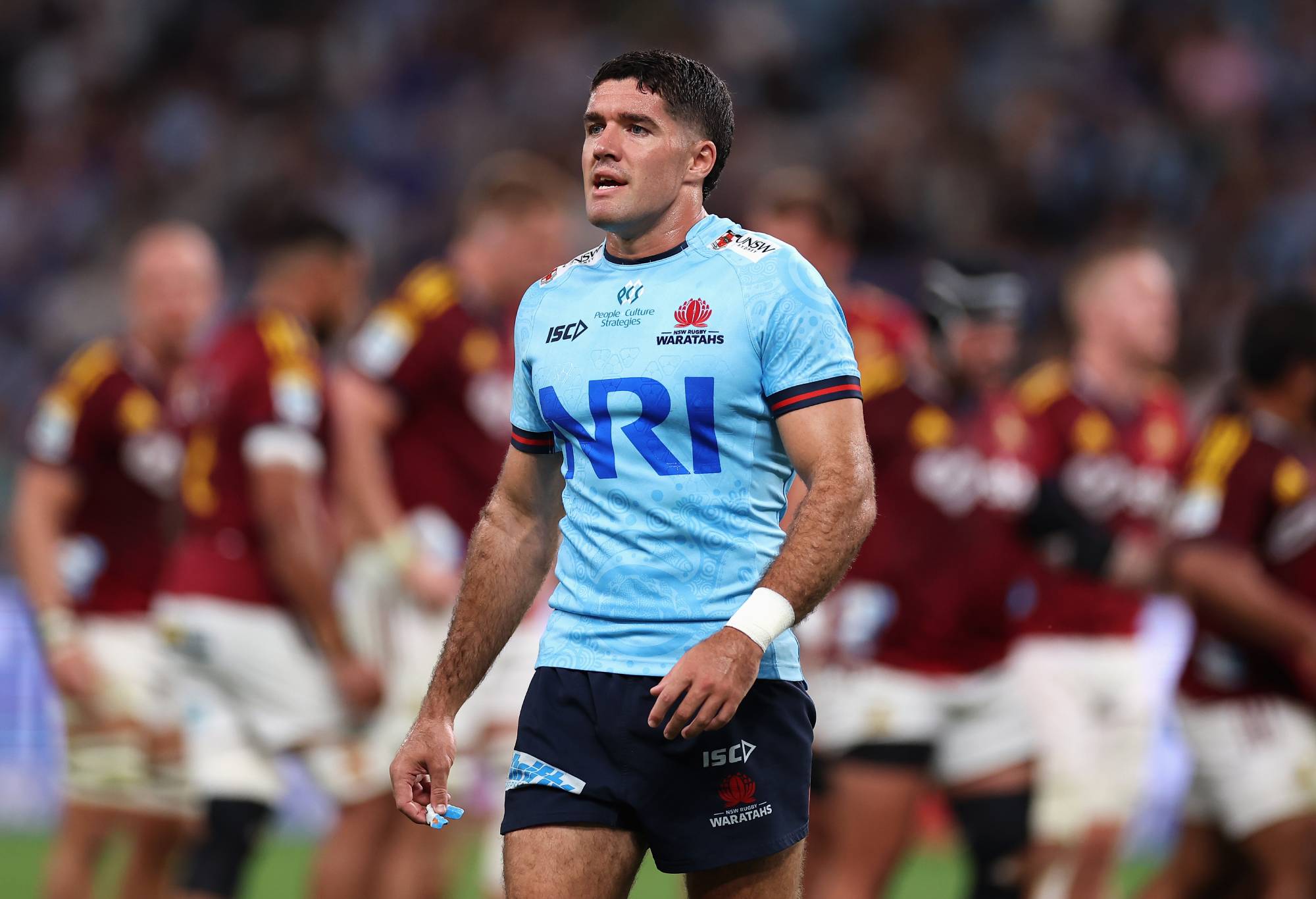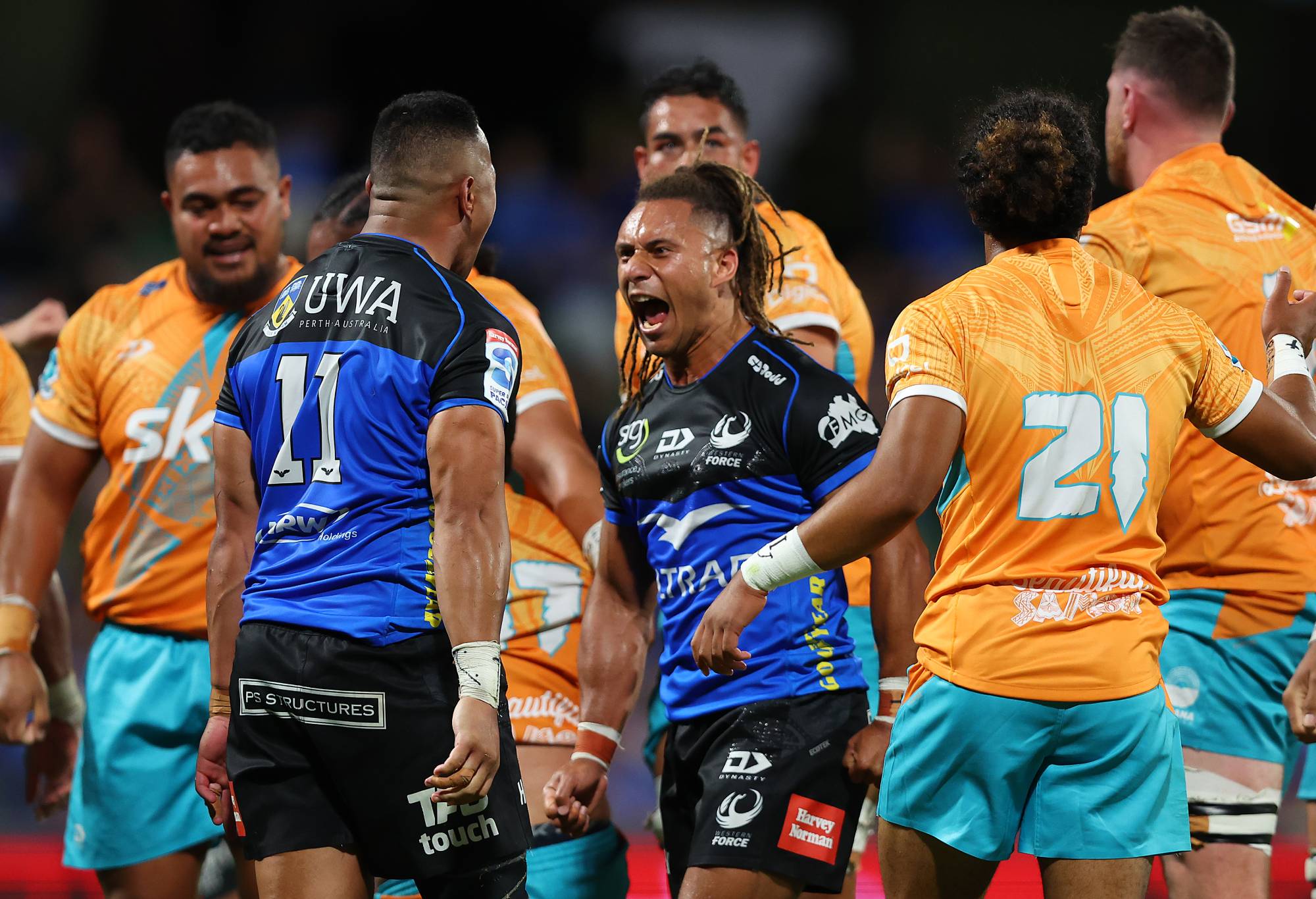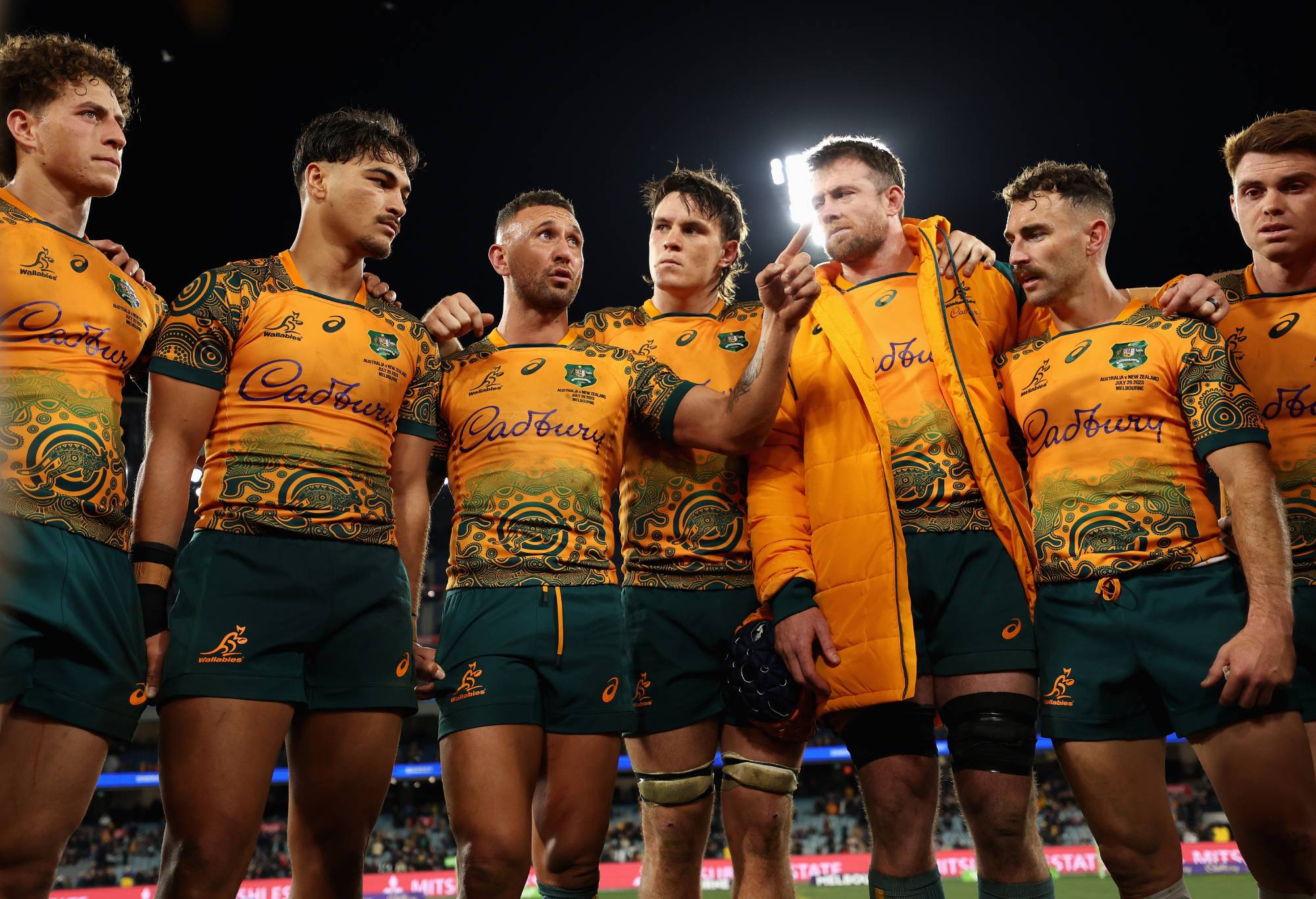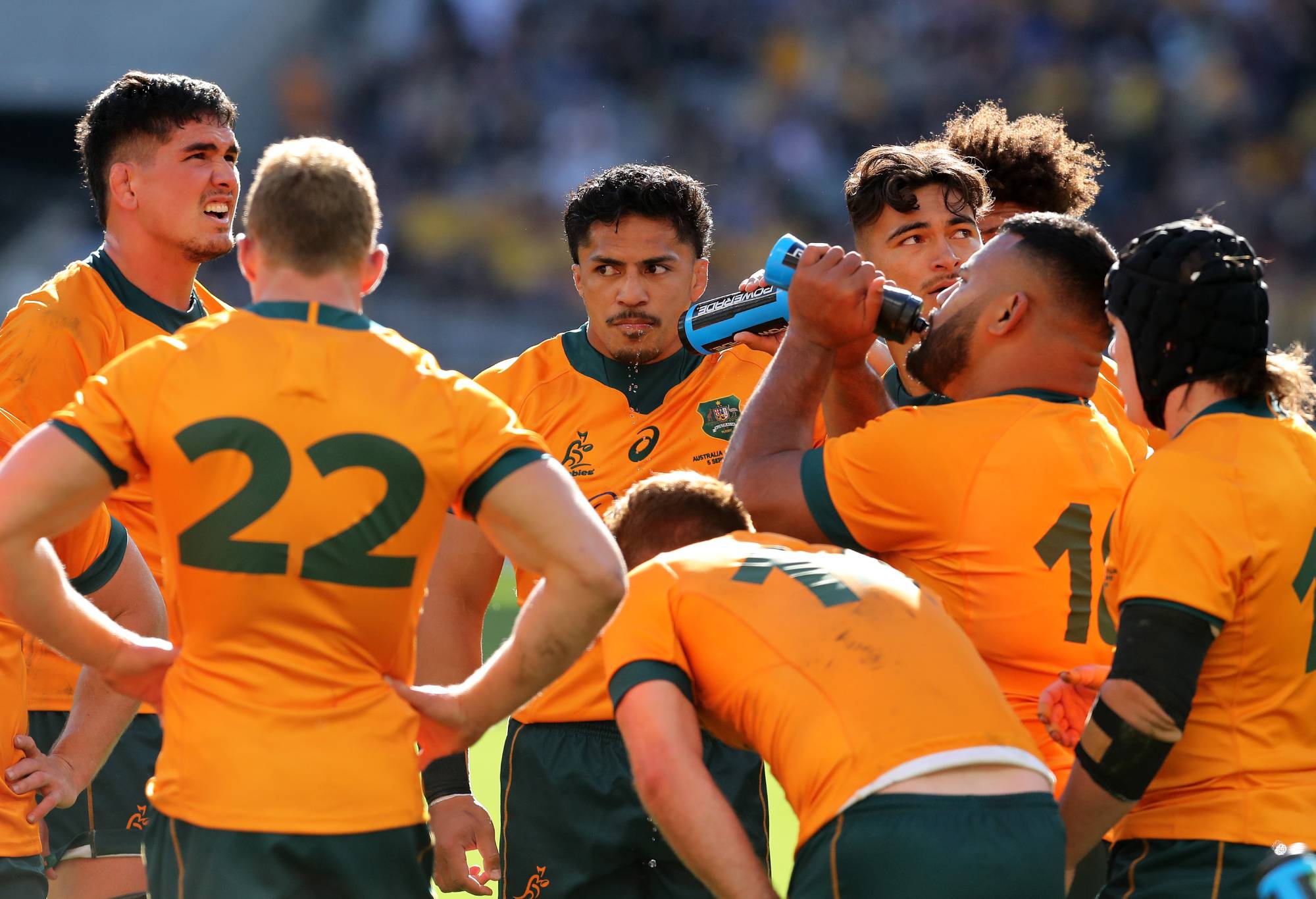Eddie Jones has thrown several curveballs in announcing his 33-man World Cup squad. Nor can he be accused of picking a conservative squad. It’s the anthesis of that.
Jones has largely backed youth, with all but five members of the squad under the age of 30. With an average age of 26 and average caps of 20, this is officially Australia’s least experienced World Cup squad since 1991.
Test stalwarts Michael Hooper, the Wallabies’ most-capped captain, and Quade Cooper, a man whose story has captivated most and spanned several junctures, have not been spared.
Jones has taken a no-prisoners approach and denied the duo to finish on a high.
Some players have been taken despite injury. Others, including Michael Hooper, have not.
Len Ikitau, a consistent cog under Dave Rennie and a quality outside centre, hasn’t played since breaking his shoulder on July 15. He was due to return in the early stages of their World Cup campaign but hasn’t been selected.
Curiously, others like Samu Kerevi (hand), Jordan Uelese (knee) and the uncapped Max Jorgensen (knee) have been selected despite the trio not yet being fully fit.
Double standards are at play, but as Eddie Jones said at his first squad announcement in April, “Selection is full of contradiction”. Indeed.

Eddie Jones has made several bombshell selections for the World Cup. (Photo by Chris Hyde/Getty Images)
Is it a squad capable of winning the World Cup? Probably not. Will it compete? Yes. And can it develop and rise from the ashes of what has been a horrible generation of Wallabies? Certainly.
That is why Jones has flipped the script and bid farewell to several household names – because the losing mentality has seeped deep into the Australian rugby psyche. As much as Hooper and Cooper gave it everything and could have still contributed in a different landscape, the next generation looks to them when all they’ve known, at least for the best part of decade, is defeat.
There remain several players with the capacity to develop into world class talents, with Angus Bell and Taniela Tupou up front, Will Skelton in the second-row, an intriguing back-row, exciting young halves and flair out wide in Mark Nawaqanitawase and Marika Koroibete.
Here are our winners and losers from Jones’ extraordinary World Cup squad.
WINNERS
Suliasi Vunivalu – Queensland Reds
The former NRL flyer is perhaps the most perplexing inclusion; albeit not an entirely surprising inclusion.
Jones has been intrigued by the strapping, powerful looking outside man ever since arriving back on Australian shores.
A NRL lover himself, Jones would have seen the former Melbourne Storm flyer score tries for fun, including on the big stage. His stunning leap and intercept against the Penrith Panthers in the 2020 Grand Final left an impression that Jones has not forgotten.
Yet, rarely, if ever, has Vunivalu looked like a rugby player – or played like one either.

Suli Vunivalu continues to divide opinion but has won over Eddie Jones. (Photo by Mark Kolbe/Getty Images)
Dogged by injuries since arriving in rugby. Vunivalu has continued to score (a strike rate of almost one try every second game) but hasn’t looked comfortable in almost any situation.
Compare him to Nawaqanitawase who has roved and looked and played like a man without a trouble in the world.
All the more perplexing is Vunivalu has only played on the right-wing.
Compare that to the excluded Tom Wright, who covers wing and fullback and it’s all the more staggering.
Ben Donaldson – Waratahs
With Cooper dispensed with, the Western Force-bound utility back is the only other playmaking option in the squad.
It’s an almighty responsibility and there’s just a hint of Berrick Barnes about the selection.
Barnes developed into a fine international player, goal-kicker and was defensively tough, but he was thrown into the deep end when Stephen Larkham went down.
It left a largely unproven No.10 running the cutter.
While he was by no means the reason the Wallabies bowed out at the quarter-final stage in Marseille, the loss of Larkham was a blow in the hearts and minds.

Ben Donaldson struggled for the Waratahs in 2023 and yet has found himself firmly in the mix to play a significant role at next month’s World Cup. (Photo by Cameron Spencer/Getty Images)
Donaldson is a talented, developing, utility back but he struggled to command games throughout the year.
He started the year at fullback, shifted to fly-half and was moved back to the No.15 jersey as the Waratahs’ season bumped along.
Donaldson had a few nice touches against the Blues in their quarter-final exit, but the fact the Waratahs didn’t want to break the bank on trying to keep the local talent summed up his season.
Nor has he featured in any of the Tests to date this year. That will change as the season goes on. Without another utility back like Reece Hodge, nor a specialist playmaker like Cooper, Donaldson could well feature heavily off the bench.
Max Jorgensen – Waratahs
A player of immense potential, Jorgensen looks a rugby player.
While he showed his ability to find the tryline in the opening stages of this year’s Super Rugby season, the rookie also showed off his fine decision-making against the Drua where he played his part in several well taken tries.
And what about his draw and pass to Lalakai Foketi against the Brumbies back in early April? It was a classy touch for an 18-year-old.
Nonetheless, Jorgensen is a selection just as much about the future as the present. Indeed, he’s still coming back from a knee-injury suffered in late May against the Crusaders.
But he provides both wing and fullback cover.
Langi Gleeson – Waratahs
Despite being unsighted through the four Tests to date, Gleeson has been included in Jones’ squads over the past two months.
The issue is, Gleeson has been coming back from a lingering leg injury that has slowed his progress.
But Gleeson was one of the few players who caught Jones’ eye early.
Against the Drua in Melbourne, he was a clear standout. He broke the line, put Fijians on their backside and played with a physicality that was unrivalled in the early matches of the tournament.
His sting was missing when he missed a large chunk of the Super Rugby season.
The early impression left a lasting impression.
How often he features throughout the World Cup remains to be seen given Rob Valetini’s presence, but Gleeson provides another ball-running option in the back-row that Jones will likely call upon at some point.
Issak Fines-Leleiwasa – Force
One of three uncapped players in the squad, Fines-Leleiwasa wasn’t the headline surprise but still caught the eye on the team sheet.
Why? Well, Ryan Lonergan had been included in every one of Jones’ squads to date, he’s a sharpshooter, has the best pass in Australia and is considered a leader for the future.
There’s a reason why Nic White has joined the Force. Lonergan is the future and the Brumbies plan for the future.

Issak Fines-Leleiwasa (C) is one of three uncapped players in Eddie Jones’ squad. (Photo by Paul Kane/Getty Images)
Fines-Leleiwasa was one of the standout Australian halfbacks during this year’s Super Rugby.
While he’s got a long way to go as a starter, the injection of pace and tempo he’s offered from the bench has been a point of difference. That’s what Jones wants.
It’s highly unlikely the 27-year-old will start a Test, but he’s a versatile player, capable of playing on the wing, and defensively sound too. He’s a baller.
Josh Kemeny – Rebels
A talented back-rower, Kemeny has been included as a “utility” player. Weird given he’s only ever played in the back-row. But this is Eddie’s mysterious world.
What Kemeny offers is a physical presence and an athletic body. He’s someone capable of playing across the entire back-row and has the speed to manage out wide if called upon.
Kemeny is the sort of player Jones likes, according to those who know him.
Tough and uncompromising, he’s a hard worker and a serious presence on the training field.
Yet, his selection ahead of Pete Samu, a proven performer in Test rugby and a winner with the Crusaders too, is curious but not without reason.
LOSERS
Quade Cooper – Kintetsu
There is no bigger surprise exclusion than Cooper.
The moment Bernard Foley was passed over for The Rugby Championship, it seemed apparent that the 35-year-old would continue his remarkable career.
That fairy tale finish has fallen flat.
Defensively there were huge concerns over Cooper’s inability to stop attackers and that is likely one of the reasons he has been left out.

Quade Cooper has been sensationally left out of Eddie Jones’ squad. (Photo by Cameron Spencer/Getty Images)
Just like Hooper recently, Cooper was allowing the opposition to get a roll on by attacking him.
But Cooper’s decision-making and failure under pressure against the All Blacks in Dunedin may well have been that last straw.
Yes, his goal-kicking stood up under pressure, but if he wasn’t going to start, Jones believes there’s better short and long-term options at his disposal.
Michael Hooper – Waratahs
Hooper’s exclusion can be explained. Easily, in fact.
His performance against the Springboks where he was targeted in defence said it all. Nor was it necessarily a mere blip. The writing had been on the wall for 12 months.
Who remembers Ellis Genge running over him in the first minute of the second Test in Brisbane? Jones was the coach that day, but for England.
Then there’s the fact he has a calf injury – the severity of which is not completely known.
Jones could have taken him if he wanted. Other international coaches have spared veterans like Brodie Retallick and Siya Kolisi. Jones hasn’t.
It’s a brutal decision, one that will be hard to stomach for most – including Hooper.
On the surface, it seems a cutthroat, unfair decision. It may be. It may also be the necessary departure from the past that is needed.
Ryan Lonergan – Brumbies
The best passing halfback in Australia, Lonergan’s axing for his former teammate Fines-Leleiwasa caught many by surprise.
It’s not just because of the width and extra time he offers for his No.10, but his goal-kicking and leadership too.
Lonergan also offers a tempo and an ability to play the game at speed and slow it down at times. Defensively, it must be said, he’s the weakest of the current halfbacks in Australia. It’s a factor that hasn’t helped Cooper.
Ultimately, Jones has elected for a game-breaker in Fines-Leleiwasa.
Pete Samu – Brumbies
A month ago, it seemed unfathomable that Samu could be left out of the World Cup, but his exclusion from the Bledisloe squad was clearly a pointer to what was to come.
Why he’s been looked over remains somewhat of an unknown.
Perhaps it’s the soaking nature of Samu’s defence?

Pete Samu is one of the surprising exclusions from Eddie Jones’ squad. (Photo by Will Russell/Getty Images)
Samu’s a soft-natured person, who is a reasonable trainer but not necessarily the biggest communicator. Did that play a part? Only Eddie knows.
What is known is that Samu is French-bound and there are several youngsters coming through who are the future. That likely had played a part (cue those questioning the rationale given Skelton plays in France and is captain – the difference is he’s world class in a position the Wallabies are desperately light in and his size will help the absence of Allan Alaalatoa at tight-head prop).
But his skill set and ability to cover the entire back-row has always been a luxury for every side he’s played in. Indeed, Scott Robertson used him phenomenally during his first two Super Rugby title successes.
Tom Wright – Brumbies
A talented player with an ability to create for those around him, Wright’s gone from Australia’s premier fullback in this year’s Super Rugby competition to out of the squad.
Like Samu, the writing was on the wall the moment he was left out of the Bledisloe squad.
There was little way back for him except for an injury to Andrew Kellaway.
Ultimately, Kellaway’s calm, safe nature was preferred to Wright’s up-and-down nature.
Wright’s rocks and diamonds twice came to pass in important situations; against the Chiefs in the Super Rugby semi-final and less than a month later for the Wallabies against Argentina in Sydney.
Still, given Wright’s ability to cover the wing, too, his axing means the Wallabies have been left with two young, developing players in Donaldson and Jorgensen and perhaps Jordan Petaia to cover fullback.
Jed Holloway – Waratahs
A part of Jones’ leadership team, Holloway was training with the wider Sydney-based players earlier in the week. On Wednesday evening, his dream was crushed.
Capable of playing in the back-row and in the tight-five, Holloway offered the Wallabies versatility and experience.
He started against Los Pumas and the All Blacks in Melbourne but didn’t quite seize the moment in either Test. That likely played against him, with Tom Hooper’s work-rate and ability to hit rucks and carry well in Dunedin seeing the youngster catapult ahead of Holloway.
Holloway’s work in the lineout had been a strength of his in recent years, but the fine hands and good passing game on display last year went somewhat missing this year.
Was it because of a chance in tactics or simply a drop of form? Perhaps both. Either way, his exclusion will be a tough pill to swallow.


































































































